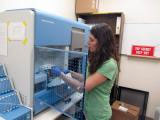Gene Sequencers Getting Cheaper, Faster
 (May 2012) Mark Johnston,
(May 2012) Mark Johnston,
“That machine changes the world,” says Johnston, chair of the Department of Biochemistry and Molecular Genetics at the CU medical school. “It makes genome sequencing incredibly cheap.”
What cost nearly $10,000 per million DNA bases in 1991 plunged to a penny last year, according to the National Human Genome Research Institute.
With about 6 million differences in DNA sequence between individuals (out of a human genome of 3 billion base pairs), there is a lot of sorting to be done.
The genome analyzer that’s part of Johnston’s lab takes only a few days to determine a genome sequence and find its characteristics and variations.
It takes purified pieces of DNA, copies them on a microscopic “lawn” of adapters, and dyes them with the four DNA nucleotides, producing a four-color Milky Way of dots that
“It’s almost a daily tool in research now,” analyzing everything from yeast to snakes to humans, Johnston says.
Here’s how fast science is moving now. The sequencer Johnston uses was delivered in
“My vision,” he says, “is in five years to see everybody here using this kind of DNA sequencing instrument in their research. It will permeate the university.”
See DNA Sequencing Costs >>